Ixalerpeton polesinensis and Buriolestes schultzi Co-existed
New fossil evidence suggests that the rise of the Dinosauria was more gradual than previously thought. Many people’s perception of the dinosaurs is that they are all super-sized monsters, dominating life on land and rapidly out competing the other, more primitive Triassic reptiles. Scientists writing in the journal “Current Biology” challenge this view, as they describe the discovery in the same rock formation of an early dinosaur and a lagerpetid, a member of a group of animals that are recognised as precursors of dinosaurs.
This is the first time that a dinosaur and a dinosaur precursor have been found together, indicating that true members of the Dinosauria Order and their near relatives co-existed.
The Skull of the Dinosaur (Buriolestes schultzi) in Situ
Picture credit: Cabreira et al
A Sauropodomorph and a Lagerpetid
A team of researchers including Sergio Furtado Cabreira (Museu de Ciências Naturais, Universidade Luterana do Brasil, Brazil) and Alexander Wilhelm Armin Kellner (Departamento de Geologia e Paleontologia, Museu Nacional-UFRJ, Rio de Janeiro, Brazil) have described two new species of Dinosauromorpha from Upper Triassic rocks in central, eastern Brazil (the Paraná Basin).
The fossil material represents a lagerpetid, which has been named Ixalerpeton polesinensis and a new basal sauropodomorph (Buriolestes schultzi), the remains of these animals were found in the Alemoa Member of the Santa Maria Formation, specifically, within the Hyperodapedon (rhynchosaur) Assemblage Zone which dates from the Carnian faunal stage of the Upper Triassic.
Ixalerpeton has been assigned to the family Lagerpetidae which together with the Dinosauria and other closely related archosaurs, make up the clade Dinosauromorpha. B. schultzi has been assigned to the Sauropodomorpha, a clade of lizard-hipped dinosaurs that would evolve into the long-necked giants such as Diplodocus, Apatosaurus and Brachiosaurus.
Line Drawings and Photographs of the Fossilised Remains of the Two New Species of Dinosauromorph
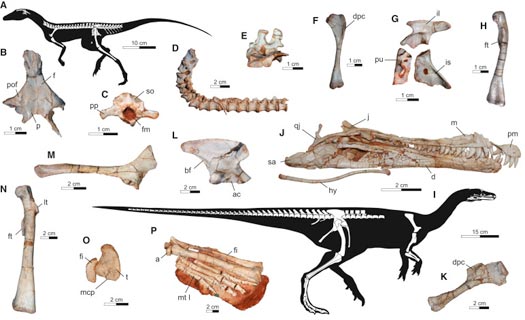
Line drawing (A) of I. polesinensis and fossilised remains of (B-H) and line drawing (I) of B. schultzi with fossil remains (J-P).
Picture credit: Current Biology
The Lagerpetid Ixalerpeton polesinensis
The lagerpetid (Ixalerpeton) has been described from skull bones including the braincase, vertebrae, one shoulder blade, the left humerus, parts of the pelvis, a thigh bone (femur) and some lower leg bones. This biped is estimated to have measured around half a metre in length.
The Sauropodomorph Buriolestes schultzi
The larger Buriolestes is estimated to have measured around 1.8 metres long and it has been described from a partial skull, which includes the premaxilla, maxilla and the dentary, a large number of vertebrae including posterior dorsal vertebrae and caudal bones, the left arm, parts of the pelvis and a nearly complete left hind leg.
For scale models of Triassic prehistoric animals and early dinosaurs: CollectA Deluxe Prehistoric Animal Replicas.
Etymology
Ixalerpeton polesinensis – The genus name means “leaping reptile”, whilst the trivial name references São João do Polêsine, the town where the fossils were found.
Buriolestes schultzi – The genus name means “Buriol robber”, a reference to the family name of the land owners and recognises that this dinosaur was most likely carnivorous. The species/trivial name honours Cesar Schultz (professor of vertebrate palaeontology at the Universidade Federal do Rio Grande do Sul).
A Timeline Showing the Relationship between B. schultzi and I. polesinensis within an Overview of Early Dinosauromorphs
Picture credit: Current Biology
Ixalerpeton polesinensis and Buriolestes schultzi
The research team are confident that further analysis of the Ixalerpeton fossil material will add to our understanding as to how the dinosaurs evolved their anatomical characteristics. The teeth of Buriolestes indicate that this sauropodomorph, a distant ancestor of the huge herbivorous sauropods, was actually carnivorous. This evidence supports the theory that the giant plant-eating dinosaurs such as Diplodocus were descended from small, bipedal, meat-eaters.
A Close View of the Teeth of Buriolestes Indicating that this Dinosaur was a Carnivore
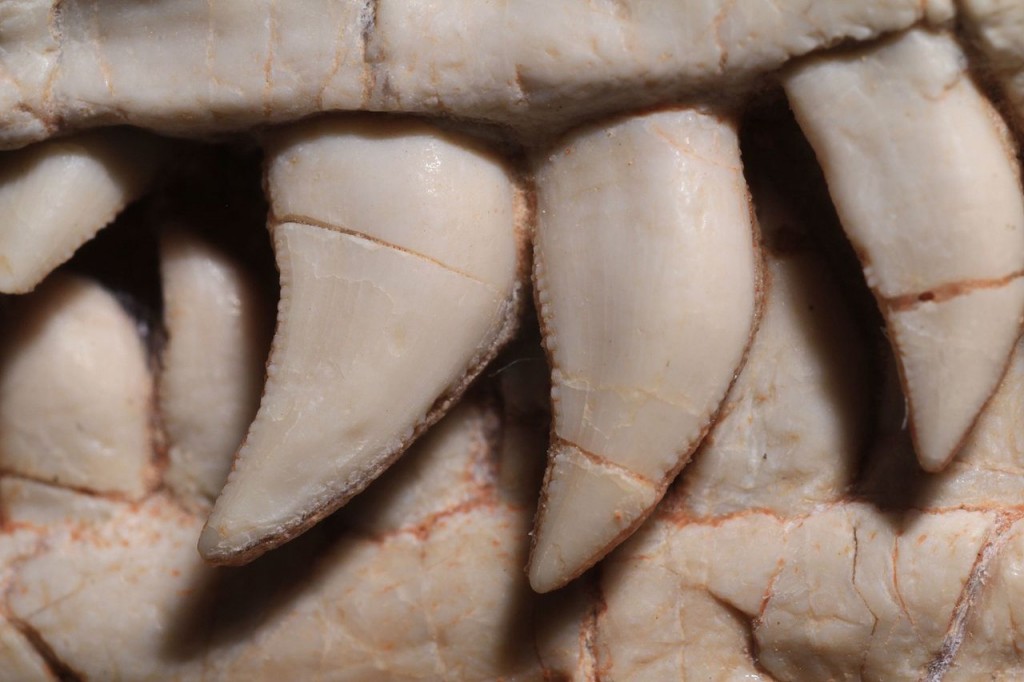
A close view of the teeth of Buriolestes. The highly recurved and serrated teeth indicate that this sauropodomorph was a carnivore.
Picture credit: Cabreira et al
The Dietary Preferences of Dinosauromorphs
An analysis of the fossil teeth of these newly described archosaurs has helped scientists to assess the dietary preferences of a range of dinosauromorphs. This research suggests that the very first dinosaurs were all meat-eaters and over time there was a move towards herbivory and an omnivorous diet within certain groups.
The Dietary Preferences of Dinosauromorphs
Picture credit: Current Biology
The diagram above shows a cladogram of dinosauromorphs and photographs of their teeth. The top photograph shows the teeth of the dilophosaurid theropod Dracovenator (Neotheropoda), a carnivore. Next comes a picture of the teeth of Buriolestes, assigned to the Sauropodomorpha but regarded as carnivorous by the researchers. The third photograph features the teeth of Pampadromaeus, which coincidentally, was named by Sergio F. Cabreira, Cesar L. Schultz et al. This little dinosaur has been assigned to the Sauropodomorpha too, it is also believed to be meat-eater. The final set of teeth belong to the later sauropodomorph Plateosaurus, that lived some fifteen million years after Buriolestes and Pampadromaeus. The teeth of Plateosaurus seem to be adapted to a plant-eating diet.
The hypothesis about feeding preferences advocated by the researchers in this paper is shown on the left of the cladogram, with alternative arrangements shown on the right.
Key
green coloured line = herbivory and/or omnivory
black coloured line = unknown or ambiguous
orange = carnivore (faunivory – feeding on other animals)
An Illustration of a Buriolestes Catching a Hyperodapedon whilst a Group of Ixalerpeton Scatter
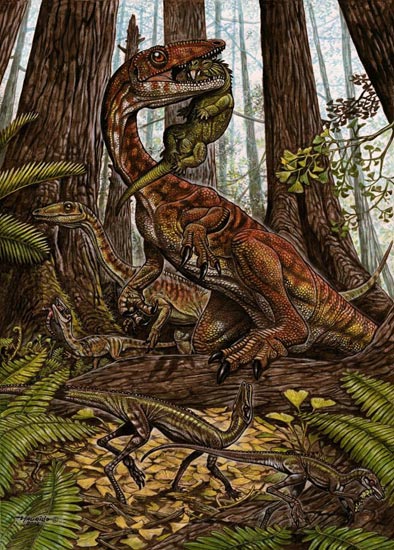
A Buriolestes catches a rhynchosaur whilst a group of Ixalerpeton hunt for lizards and grubs in the undergrowth.
Picture credit: Oliveira Maurílio
Dinosaurs Evolved in the Southern Hemisphere
This research lends weight to the hypothesis that dinosaurs evolved in the Southern Hemisphere and that the Dinosauria were carnivorous in their basal forms, it also supports the idea that lagerpetids and early dinosaurs were contemporaries since the first stages of dinosaur evolution.
The scientific paper: “A Unique Late Triassic Dinosauromorph Assemblage Reveals Dinosaur Ancestral Anatomy and Diet” published in Current Biology.
Everything Dinosaur’s website: Everything Dinosaur.


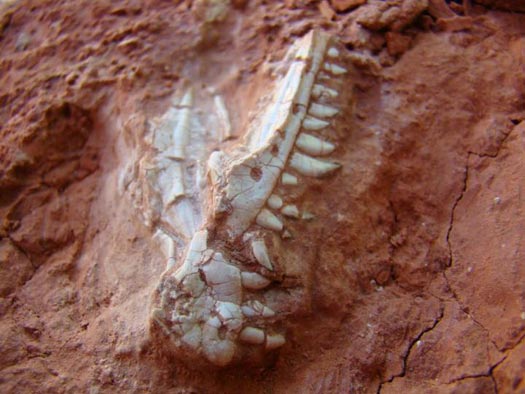
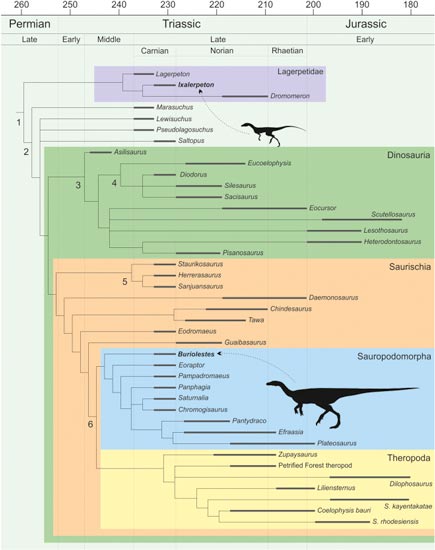
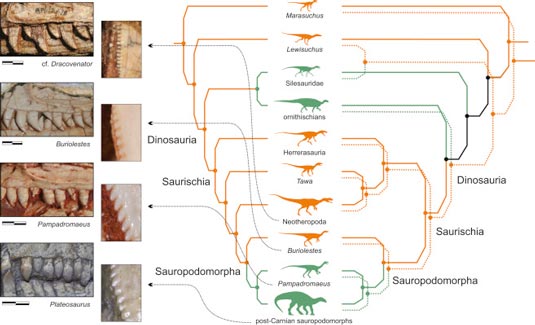




Leave A Comment